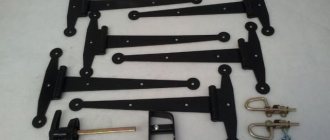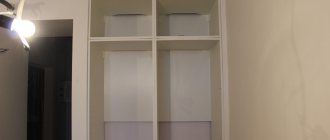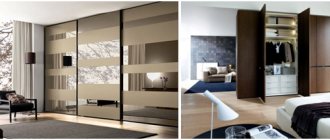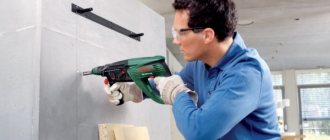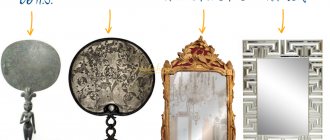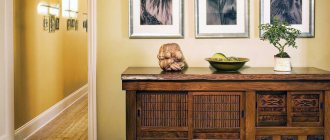Before adjusting furniture hinges, you should familiarize yourself with the general rules for carrying out work:
- When adjusting any hinges (including those with a door closer), you must first align the vertical gaps along the entire length of the sash, after which you can adjust the doors according to the landing height. Using this procedure, you can significantly speed up and simplify the process of setting up furniture fittings, since you do not have to correct the previous steps (the settings will be lost in the reverse order).
- Before you start setting up furniture fittings, you should make sure that the piece of furniture is standing or hanging strictly level in all planes. You can check the correct position of the furniture using a small building level or by using a special application on your smartphone that shows the level.
- If it is not possible to set the level, and the furniture is slightly overwhelmed, you should pay more attention to the gaps on the front doors, which in this case will be larger. Furniture that stands level can be provided with smaller front gaps. In most cases, the optimal gap for level furniture is 3-5 mm.
- Make sure that the fit of the façade under the cup is correct - if this is not the case, it is unlikely that it will be possible to make precise adjustments that will last for a long time. Very often, correct adjustment is completely impossible in such cases, so you will have to adjust the hinges after correcting the situation with the addition of the facade under the fittings cup.
Now that you have memorized the valuable recommendations described, you can begin to set up the furniture fittings itself, which is carried out simultaneously in several planes.
What you need to adjust furniture hinges
Of course, the appearance and position of the doors on a kitchen or wardrobe depends entirely on the skill of the assembler. If no gross mistakes were made when installing the hinges on the door and the inner wall, then it is quite possible to adjust the hinges on the kitchen cabinet doors with your own hands without outside help.
Hinge adjustment points diagram
In order to correctly adjust the position of the awnings, you only need three tools:
- Construction level with bubble chamber;
- Wooden school ruler;
- Crosshead screwdriver.
A caliper may come in handy if you suddenly need to adjust four hinges on a wardrobe at once. Sometimes it will be useful to get a flashlight or a portable lamp if we are talking about setting up awnings on a cabinet in an inconvenient or poorly lit area of the furniture wall. The process takes 5-10 minutes, depending on the experience and condition of the furniture facade.
You can only insert a loop using a template
They are probably made with maximum positioning accuracy on the cabinet door, so you cannot even try to adjust the position of the doors on the cabinet by re-milling the “cups”.
How to adjust furniture hinges
To properly set up the operation of the canopy, you first need to check the position of the cabinet itself. Doors on the facade will help sag under their own weight or due to skew of the body. To do this, we check the position of the box with a level and level it either by altering the suspension on the wall, or by trying to adjust the height of the legs.
Any mortise hinge has at least three position adjustment screws. In general, the system allows you to adjust the position of the door, its displacement by 2-4 mm vertically, horizontally and in depth. Since there are usually two loops, the angular deviation can also be corrected. A more detailed description of the screws for adjusting furniture hinges is given in the video:
But you can also use the diagram below.
How to adjust furniture hinges vertically
In all training manuals and manuals, it is usually recommended to begin adjusting the door position by eliminating the most obvious problems with the hinges. If the screws are not screwed deep enough or are loosened at both fastening points, then one half of the facade will simply drop a few millimeters lower relative to the other.
In this case, you will need to unscrew the screws, place a piece of a match or toothpick in the hole and tighten the fasteners.
If the fastening is in order, you can adjust the height of the sash by unscrewing the screw 1-2 turns. Next, we will raise the cabinet door level with the other half, fix it and at the same time raise the “butterfly” hinge to the same height. All that remains is to tighten the fasteners with a screwdriver, use a ruler and a level to check the accuracy of the installation.
How to adjust furniture hinges horizontally
Since when opening a cabinet a person usually grabs the corner of the door with his hand, the main part of the load falls on the nearest hinge. As a result, the door may warp, the upper parts of the two doors will collide head-on, and a huge wedge-shaped gap will form between the doors below.
In this case, you have to adjust the horizontal displacement along the front on one of the hinges, usually the top one. To level the position, you will need to unscrew the adjusting screw, which is located first from the end, as in the diagram.
Before adjusting, you need to loosen the screw, align the door and only then tighten the fastening point
If a cabinet with a skewed door has been in use for a long period of time, then you will probably have to adjust the lower canopy. Using a school wooden ruler, it is convenient to control the size of the gap between the edges of the sashes, so as not to adjust, as they say, “by eye.”
You can configure cabinet doors with four hinges in the same way. Initially, you need to adjust the gap on the top and bottom hinges, then use the screws to level the gap in the middle of the sash. One of the options for adjusting the horizontal reach is shown in the video:
How to properly adjust furniture hinges in depth
Front or depth adjustment makes it possible to adjust the size of the gap between the ends of the side walls of the cabinet and the ends of the door in the open position.
Frontal adjustment is the most important; the durability of the hinge depends on the accuracy of the gap setting.
If the doors do not open completely to an angle of 90°, then most likely there is no working gap at all. To fix the problem, you need to adjust the specified distance at 0.6-3.4 mm. Again, it is very convenient to use a ruler as a gauge.
Adjusting the gap is easy:
- We turn out the screw farthest from the facade;
- Place a ruler on the end of the wall and fix it with your hand;
- Next, you need to adjust the protrusion of the screw with a screwdriver so that the cabinet door leaf opens fully.
It is also not recommended to make the gap too large; in this case, you will have to additionally adjust the position of the horizontal movement with a nearby screw.
Repair using furniture confirmations
To secure the hinge, you can use special furniture fasteners - confirmats.
They look like self-tapping screws, have sharp threads, but are made of softer metal
These fasteners have a larger diameter and sometimes it is enough to replace ordinary screws with them to return the door to its place
To insert furniture fasteners, you need to drill out the damaged hole. Use a drill stop to prevent the door from going all the way through. It could even be a simple plastic tube from a felt-tip pen, like the author’s
Then simply put the loop in place and secure it with a confirmat. But don't forget to add a self-tapping screw in the center of the hinge for reliability.
An alternative would be to use a metal liner. It is screwed into the hole and then a self-tapping screw is attached to it.
Self-adjustment of hinges on cabinet doors - instructions with photos
Door distortions, their loose fit, difficulties with opening/closing - there are quite a lot of problems typical not only for new furniture after its assembly is completed, but also for old ones. First of all, this applies to elements of kitchen units, the awnings of which are affected by changes in humidity, temperature, and their high values. As a rule, most defects that appear can be eliminated by adjusting the hinges on cabinet doors. And the services of a specialist, if you understand the meaning of all operations, are definitely not needed.
All a home craftsman needs is a cross-head screwdriver, since the awnings are fastened with self-tapping screws. And, of course, an understanding of what needs to be done.
Where to begin
- Assess the correct installation of furniture. If it is skewed (uneven floors, differences in the height of its legs), then adjusting the cabinet doors may not help. Therefore, it is necessary to eliminate this shortcoming. Controlling the position of furniture is best done using a building level or plumb line; It is quite difficult to visually determine deviations from the vertical, especially minor ones.
- Inspect the awnings. This is necessary, firstly, to determine their type (the methodology for further work largely depends on this), and secondly, their condition. If the fasteners are loosened, adjustment will not be necessary; You just need to tighten the fasteners more tightly.
- Determine the type of regulation. It depends on how curved the cabinet facade is, where there are large and small gaps between its doors, in which area the fabric catches, and so on. Then it will become clear how exactly it should be adjusted: in height, depth or width.
Video: How to adjust wardrobe doors yourself
23148
Many people have encountered situations where wardrobe doors no longer close tightly and look warped. To avoid deformation of the door closing system, you will need to eliminate all problems. Many people are looking for information and want to know how to adjust wardrobe doors; to do this, you can contact a specialist or fix the defect yourself at home.
Operating procedure
It should be noted that the first time you may not get the desired result. And this depends not only on the qualifications of the master. Many malfunctions are caused by several reasons, each of which entails certain negative consequences for the correct opening/closing of doors and their position on the cabinet facade. Therefore, adjustment is often carried out comprehensively, along several axes.
By height
This is necessary in case of obvious distortion. It begins to touch the bottom or top of the cabinet partitions with its upper cut; difficulties arise with closing tightly, since adjacent doors literally rest against each other with the ends of the panels.
In most types of hinges, the screw, which is responsible for the vertical displacement of the blade, is located in a round rather than an oblong hole, stretched in the form of an ellipse. It is always located closer to the sash.
When determining how to adjust cabinet doors, you need to consider that their position is affected by both canopies. It is necessary to loosen the fasteners, move the blade, tighten the screws slightly and check for opening/closing. As a rule, two or three attempts are enough, and the deficiency is eliminated.
Width (depth)
Here you will have to “work” with another screw. It is easy to determine by its installation location - it is further from the edge of the section, and the landing “window” has an oblong shape. This is what allows you to find the optimal position of the hinge relative to the wall of a kitchen or other cabinet. The fastener becomes loose and the moving part of the canopy either moves inward or is pulled out. The adjustment range is determined by the length of the “window” in which the screw is located.
The technique is identical: loosening the adjusting element - changing the position of the door - tightening the fasteners - assessing the result of the work. But in this case, you will have to screw in/unscrew both screws (both the far and the near), otherwise the hinge simply will not budge.
The question of how to adjust cabinet doors equipped with a closer also does not seem difficult. As a rule, this is necessary if there is a loose fit or slow closing (increased inertia). Such mechanisms differ only in the specifics of installation (on the hinges, between them), but their “tuning” is carried out according to a single algorithm. It all comes down to changing the position of the screw, which affects the intensity of movement of the spring. During the regulation process, it is weakened or tightened.
Adjusting the hinges is not done at once, and there is no need for haste; This kind of work requires extra attention. To install the sash in the desired position, you will have to perform several, sometimes identical, operations. But each of them is an experience, and therefore it will take much less time to eliminate the distortions of the second and third doors.
How to adjust hinges on a cabinet door, detailed instructions
When arranging a room, you should not only think about the proper furnishings and stylish decoration, but also choose comfortable furniture. When choosing furniture elements, especially cabinets, you should pay special attention to door hinges. It is important that the structures can be opened and closed with ease. When assembling cabinets, you should carefully inspect all the component elements, and it is better to independently adjust the hinges to the required level. A process such as adjusting hinges on cabinet doors is not at all complicated; the main thing is that you need to carefully study all its features.
Repairing a hinge with a wooden dowel
Another practical option for repairing a hinge is to use a wooden dowel. It is made from hard wood, so it will securely hold the screw.
Select a suitable piece of wood and drill a hole in the wall for it, again using the stopper
Before installing the dowel, fill the niche with PVA glue - it will additionally fix the part
The dowel should fit tightly into the wall. And after the glue dries, you need to cut off the excess and trim it
To prevent the dowel from cracking when tightening the screw, you need to drill a hole in it with a thin drill
Adjustment options
Adjusting any type of wardrobe - wardrobe, kitchen, hallway, bathroom - ensures convenient use of this furniture. Typically required when purchasing new furniture or when moving old furniture items to a new location. This may also be necessary if the cabinet doors have become old or become loose.
To tighten the hinges, you do not need to have special skills or extensive experience. You can do everything yourself, quickly and without much difficulty. The main thing is to have a shaped screwdriver at hand.
Door adjustment is usually done in several ways. There are three options in total:
- vertical;
- performing door height adjustment;
- along the plane.
But to understand how to adjust correctly, it is worth carefully considering the features of each type.
Vertical
Vertical adjustment is the process with which the adjustment of furniture fittings usually begins. Adjusting hinges using this method is required when the door is located in an incorrect, crooked position, stands out from the general appearance of the furniture structure, or if there are two doors, and one is higher than the other.
So how to adjust the doors vertically. This adjustment option is made in 4 steps:
- First, open the door leaf. We find the hinges; if there are plugs, they need to be removed;
- on the areas of the two hinges, tighten the bolts that are located near the edge of the sidewall. These fasteners ensure the vertical position of the façade. At the very beginning, the two bolts need to be placed at the same level, this will help to adjust them correctly;
- then the door to the front part of the cabinet closes. Carefully inspect the entire structure in space, this will help identify irregularities. If there is a level of inclination of the upper corner to the right area, then on the upper hinge you need to tighten the adjustment bolt tightly, but on the lower hinge you should loosen it;
- Be sure to carefully check steps numbered 2 and 3. This must be done until the front part is in the normal position.
Adjustment in planes
As you know, there are three planes: vertical (frontal), horizontal and profile (“back and forth”). Accordingly, the loops are adjusted in them.
To adjust the position of furniture, use a special building level.
Using furniture hinges, you can change the position of the facade on the plane - this is useful when the doors are poorly pressed to the body.
In this case, it is enough to twist the second adjusting bolt on the furniture fittings.
In order for the cabinet to last a long time, you need to adjust the hinges on the doors in all directions at once.
Before setting up furniture hinges, the vertical distances are aligned to the height of the door, and then adjusted according to the positioning.
It is better to adjust vertically first.
It is better to adjust vertically first. Frontal adjustment is necessary when the door stands out from the overall picture of the furniture, or one is located above the other (in the case when there are several doors on the model). This operation is carried out in four stages:
- You should open the doors and find the hinges, then remove the plugs (if any).
- On all canopies, tighten the screws that are located closer to the sidewall. The vertical position depends on these bolts. The screws initially need to be balanced in order to decide on further actions.
- Close the doors and pay attention to the general position relative to the cabinet. If the upper corner is directed to the right, then you should also tighten the bolts on the upper hinges, while loosening the ones on the lower ones.
Frontal adjustment is necessary when the door stands out from the overall picture of the furniture, or one is located above the other (in the case when there are several doors on the model).
One of the types of adjustment: “back and forth”, or profile. This method allows you to reduce or, conversely, increase the distance. Loosen the screws a little and push on the doors or pull towards yourself, tighten the bolt again.
Correctly performed adjustment will not force you to go back.
To ensure complete balance of the facade, stages 2 and 3 should be repeated.
Tighten the bolt to bring the corresponding door corner closer to the frame. Reverse actions (loosening) allow, on the contrary, to move the corner away from the frame.
This door adjustment is used when the door is hanging at an angle.
Loosen the screws a little and push on the doors or pull towards yourself, tighten the bolt again.
Independent work on adjusting door hinges is beneficial and helps to save on maintenance, but also gives a lot of positive emotions from the result obtained. Proper adjustment will not force you to go back .
The cabinet hinges can be adjusted horizontally.
Independent work on adjusting door hinges is beneficial and helps to save on maintenance, but also gives a lot of positive emotions from the result obtained.
The durability of the fasteners is affected not only by the adjustment of the fittings, but also by the correctly selected fasteners.
One of the types of adjustment: “back and forth”, or profile.
Close the doors and pay attention to the general position relative to the cabinet.
This door adjustment is used when the door is hanging at an angle.
Caring for fittings
We have already understood how to install and adjust the hinges, but it is important to preserve these elements for a long time. You definitely need to be able to adjust and lubricate these components, this is what will help protect them from rapid wear.
Below are general recommendations for caring for hinges:
- The first adjustment of the hinge elements must be done after screwing them into place;
- The amount and frequency of subsequent care will depend on the intensity of use of furniture structures. If the doors do not open so often, then it will be enough to adjust the hinges 2-3 times a year; with frequent use, even 4 times may not be enough;
- be sure to regularly inspect the appearance of the front part of the cabinets; if distortions or a low level of the rebate are suddenly discovered, then it is necessary to make precise adjustments;
- In order for furniture fittings to maintain their quality for a long time, it is necessary to lubricate the hinges. Can be lubricated with motor oil with a mineral or synthetic composition;
- In order not to hear noises, and also not to feel difficulties when opening and closing cabinet doors, you need to lubricate all hinges with motor oil once a year.
When adjusting, try to adjust three main parameters at once - height, plane and vertical. This will help prevent imbalances that could place heavy, uneven stress on the hinges.
Setting up hinges is not that difficult; the whole process will take on average no more than 10 minutes. But at the same time, it will help preserve the quality of the hinges and the entire structure for a long time. The main thing is that when adjusting the hinges, do not forget about the recommendations and proper care of the fittings.
How to repair a hinge with epoxy resin
To repair larger damage, epoxy resin can be used. This is a plastic material that, after hardening, turns into a hard surface.
Epoxy resin consists of two components that must be mixed thoroughly before use.
You need to tightly fill the damaged hole with resin and level the surface flush with the main one.
While the resin has not hardened, you need to screw the confirmat into it and leave it until it hardens completely. The fastener can then easily be unscrewed from the wall and reinstalled along the thread through the loop
Instead of a confirmat, you can use a regular bolt: cut off its head and make a slotted thread at the end
Glue the bolt with the threads facing out using epoxy glue or drown it in resin, as in the previous version
Then install the loop and secure it with a suitable nut.
If the inner surface of the wall is white, you can mask the repair area with a regular corrector, and for colored surfaces, select a suitable paint or cover the area with self-adhesive film
You can also use filling the hole with cotton wool soaked in PVA glue. When the glue hardens, you can screw a self-tapping screw into this place
How to adjust the hinges on a cabinet door yourself: detailed instructions
If the doors become loose, begin to close poorly, or become deformed after transporting furniture from one place to another, the cabinet hinges need to be adjusted. The causes of malfunctions may be temperature changes or high humidity. Also, the procedure is often necessary after purchasing and installing new furniture. No special skills are required to adjust the awnings. All you need is tools.
The process itself is simple and takes little time, so you can adjust the doors yourself. You just need to follow some rules and subtleties, since each case requires its own specific method of adjustment.
Types of hinge adjustment
Before you start adjusting furniture hinges, you need to determine the cause of the misalignment. This can be done as follows:
- Check that the cabinet is assembled and installed correctly. If there is misalignment, adjusting the awnings may not be useful. First you need to determine what caused the displacement - different heights of the floor or legs, incorrect assembly, etc. It is better to level the furniture structure using a special construction or plumb line.
- Inspect the hinges themselves. This way you can determine the type and condition of the awnings. Without this, it is impossible to choose a solution, since repairing each type of mechanism requires certain types of work. If the problem is that the hinges are loose, just tighten them with a screwdriver.
- Determine the type of adjustment required. It is important to detect the location of the gaps, their size, radius of curvature, and the area where the blade catches. Knowing the “scale” of the problem, you can choose a way to adjust the canopies: height, depth or width.
Before setting up hinges on the cabinet door leaves, you need to decide on what principle the work will be performed. There are several types of regulation:
- by height - performed if one door is located higher or lower than the other;
- in width - if there is an uneven gap between the doors;
- in depth.
Sometimes distortions occur because the furniture was assembled incorrectly or on an uneven surface. Therefore, it is first recommended to check the geometry of the cabinet using a plumb line, and if it is skewed, set it level. Often no further adjustment of the hinges will be necessary.
Vertical correction
Adjustment of a furniture hinge begins with adjusting the vertical position.
This method eliminates the uneven position of the door leaves relative to each other or their separation from the overall design of the cabinet.
Loops are found on the adjusting mechanism. If there are plugs, they are removed. Then they find oblong recesses in which two screws are located - in the upper and lower parts of the fittings. Using a screwdriver, the bolts are loosened slightly, and the cabinet doors are raised or lowered to the required level. To fix the position of the doors, the screws are tightened, holding the doors in the desired position.
After aligning the door leaves vertically, begin adjusting the remaining levels. If you start correction horizontally or in depth, you will have to constantly return to the beginning. This adjustment will resemble “pulling a blanket.”
Horizontal adjustment
To align the doors in height and prevent constant friction of the door leaves against the horizontal slats, it is necessary to adjust the special mechanisms that secure the doors. Inside the structure there are small oblong ears where the screws are located. Using a screwdriver, loosen the screws by carefully unscrewing them. In this case, it is necessary to ensure that the doors do not warp.
If necessary, during adjustment the façade panels are lifted and then the screws are tightened, but not too tightly so as not to break the threads.
Depth adjustment
This type of adjustment is required when the doors or one of the curtains constantly move in the opposite direction or do not fit tightly against the wall of the wardrobe.
To eliminate the distortion, find a second adjusting bolt. Take a screwdriver and tighten the screw in your direction by 2-3 mm. During the process, it is important to constantly ensure that no cracks or gaps form between the door panels and the facade.
If the twisted 2 mm is not enough, then you need to continue the process until complete alignment.
Video - Adjusting wardrobe doors
Extraneous sounds
Despite the fact that many owners of sliding wardrobes are not bothered by the presence of creaking and other sounds when the doors move, this condition indicates that there is a malfunction somewhere in the mechanisms. Normally, doors should move smoothly, quietly and without any vibration or bouncing. Any of the listed “symptoms” speaks in favor of weakening of the fastening elements, which may soon make itself felt in the form of more serious manifestations.
Fittings and fasteners for sliding wardrobes
In order to eliminate this unpleasant phenomenon, it is necessary to adjust the roller mechanism responsible for the smooth movement of the sashes. In order to carry out this task, you must first remove the doors and thoroughly tighten the fastening. When tightening, it is important to ensure that the overhangs of the rollers on all sides are symmetrical to each other. It is the absence of an overhang on one of the sides or the misalignment of one of the rollers that provokes “interference” when the doors move.
By the way! Sometimes the cause of squeaking is a simple lack of lubrication on the rollers.
Roller lubricant
Removing the doors
Learning how to remove and put on wardrobe doors is very important, since you may need this action more than once when repairing or adjusting some parts. When moving the door leaf, it is very easy to make a mistake, which can result in related problems such as the door skewing or even falling out. In this regard, it is important to adhere to a fixed procedure.
Step 1. Lift the door, then feel for the wheel, and then carefully remove the wheel from the guide. Repeat this procedure for all of your closet doors.
When lifting the door, avoid sudden movements
Step 2. Holding the door on both sides, lift it up, then pull it towards you.
To prevent the door from sagging, it is important to grab it at both ends
Step 3. When putting the doors back, start inserting them from the top guides.
Returning the door to its place begins with the upper guides
Step 4. Once the door fits into the tracks, place the wheels on the prepared rails.
The further movement of the doors depends on the correct location of the wheels.
Please note that different wardrobes have their own specific mechanisms, so there are no universal instructions for disassembling them. Above we indicated the most general procedure.
Time frame for eliminating the defect
Even those deviations in functioning that seem insignificant to you require attention. The fact is that the longer the defect manifests itself, the more damage it causes to the mechanisms, as if gradually wearing it out. The result of ignoring obvious interference may be the failure of the entire sliding system as a whole, which will no longer be possible to cope with without a specialist.
The further period that the cabinet can serve you depends on the timeliness of adjustment.
The web jumps off the guide track
The jumping of the canvas and the lack of smooth movement of wardrobe doors are often explained by the same reasons:
- entry of foreign objects into the lower profile (from accumulation of dust and wool to chewing gum, parts of children's construction sets, etc.).
When colliding with an obstacle, the door either literally jumps out if the object completely blocks the rail, or jumps, which also indicates the presence of extra objects; Profile blockage is one of the most common causes of door jams - sudden closing and opening of doors.
If you handle the doors carelessly, a reverse inertial movement periodically occurs, throwing the door up and causing it to fall out. At the same time, it almost never falls out completely, due to fixation using the upper guides. Wardrobe doors are not designed to withstand harsh handling.
Removing debris from the lower profile is quite easy:
- remove the door from the cabinet according to the step-by-step instructions indicated in the previous chapter;
- remove the foreign object. This action is not always the easiest, especially when it comes to sticky gum. In extreme cases, it is necessary to replace the entire lower profile;
- to improve sliding, you can lubricate the rails with paraffin or graphite lubricant;
- put the doors back in, starting from the top rails and ending with the bottom ones.
Regular paraffin is excellent for lubricating rails.
Care and prevention
To avoid having to constantly adjust cabinet doors, it is recommended to carry out preventive measures that will help protect the product from rapid wear and distortion.
Care instructions:
- the first adjustment is made immediately after installation and assembly of the furniture (cabinet);
- if the furniture is used infrequently, then adjustments and tightening of bolts are carried out 2-3 times a year, with frequent use - once a month;
- It is recommended to inspect the appearance of the door panels for distortions, deviations, and other defects;
- for better operation and prolongation of the functions of the adjusting mechanism, it must be lubricated with motor or other suitable oil;
- To prevent impacts, you can install a special oil closer; it promotes smooth closing and prevents the canopies from coming loose.
After lubricating the mechanism, it is recommended to open and close the door several times to better penetrate the oil into the device.
The process of correcting distortions in the design of door panels takes little time, and inspection and preventive actions take even less.
Adjusting hinges on cabinet doors
Furniture in our homes is not only a part of the interior that pleases the eye with its beauty or unusual design. In most cases, it is also an item that carries a certain functional purpose, for example, storing clothes, dishes or other small things important for our everyday life. Properly selected furniture is the key to a comfortable home arrangement.
To prevent personal belongings from spoiling the interior of the room, creating a mess in it, they are usually put away in a closet. This convenient and practical piece of furniture can be found in almost any home today, therefore, the problem of adjusting hinges on cabinet doors is undoubtedly familiar to many.
Ways to adjust hinges on cabinet doors
There are several ways to adjust door hinges. They all involve performing a series of simple actions that any homeowner can do, even without special skills. Let's take a closer look at them.
There are three main ways to adjust hinges:
- vertical;
- door height adjustment;
- plane adjustment.
Each of these methods is characterized by its own distinctive features. You should first of all pay attention to these features when choosing the door adjustment option that is best suited for a particular situation.
Vertical adjustment
It is used when assembling new furniture or in cases where there is a pronounced distortion between the doors and the cabinet.
Before starting work, remove the plugs, if any. Then, tighten and align the bolts located along the edges of the cabinet side. After closing the door, analyze whether it is now level and whether any of the bolts need to be further tightened. For example, if the upper corner of the door is tilted to the right, then the upper hinge is tightened and the lower one is weakened; if it is tilted to the left, vice versa. Door adjustment does not allow sudden actions. You should not immediately completely tighten or unscrew the bolts - there is a high probability that such actions will only increase the existing distortion or loosen the grooves. Make adjustments gradually, checking the result after each step and continuing to tighten the bolts until you align the doors as you require.
Having finished leveling the doors using this method, you can begin to level their height. However, it is quite possible that after learning what this method is and assessing the degree of its necessity for your particular case, you will decide that it will not be useful to you.
Door height adjustment
When making vertical adjustments of doors, you should be as careful and attentive as possible so as not to damage the furniture. The height of the door is changed by tightening or loosening two special screws mounted on elongated ears.
First, you need to loosen the screws, then set the cabinet doors at the height you need, and then fix it by tightening the screws. It is better to choose self-tapping screws for this manipulation with small threads - with their help it is much easier to install the doors to the required height.
Adjustment in planes
Using this method, you can align the position of the doors in the plane and eliminate their loose fit to the body. Scroll the second bolt located in the loop towards you. After performing this action, see if there is a gap between the cabinet body and the door. If necessary, perform these steps several times until the gap is removed. To carry out such manipulations, it is better to choose a Phillips screwdriver. The actions themselves should be carried out extremely carefully so as not to damage the head of the bolts or twist the threads on them.
Rules to follow when adjusting doors
Despite the fact that these methods are quite different, when using any of them, certain rules must be followed:
- Perform all actions sequentially - this way you will not only significantly speed up the entire process, but also make fewer errors. First, the doors must be aligned in height, and then they must be adjusted in relation to placement.
- Before adjusting the doors, you should check how the cabinet stands - if it is not level, then you must first adjust its installation and only then take on the doors.
- If it is impossible to level the cabinet, then you should pay special attention to the distance formed between its doors, which becomes when the optimal number of things is placed in it. Remember, if the cabinet is overcrowded, the existing gap will increase significantly. It is believed that the size of the permissible gap between the doors should not exceed 5 millimeters.
- It is recommended to check the facade additive under the cup. If it is incorrect, the process may be delayed, since you will first need to adjust the door hinges, and only then carry out actions to adjust the doors.
Why don't all furniture makers do this?
Furniture installers are usually in a rush to get the job done to meet the next order. This is probably the only justification for why many of them do not perform all the required manipulations to install the hinges, and this subsequently leads to their damage.
Modern hinges look like this: they not only have fastenings to the body and door, but also adjusting bolts
To separate the loop, you need to unscrew these two bolts: they will release the parts and the loop will split into two parts
And now - attention: at this stage you will discover how conscientiously the furniture makers did their work. On the hinge, in addition to the two screws at the edges, another one must be screwed in - in the center.
Sometimes, to repair a loose hinge, it is enough to screw in this self-tapping screw, and even on it alone everything will be held very securely. Just choose the right self-tapping screw so that it does not pierce the door right through
If the hinge is positioned so that there is a double wall underneath it - from this shelf and the adjacent one - you can fasten a self-tapping screw directly through both walls
Caring for fittings to extend their service life
To extend the life of your cabinet, it must be properly maintained by following a few simple rules:
- Once the doors are adjusted, the screws on the hinges holding the doors in place need to be tightened as tight as possible. This will help strengthen the structure and prevent them from periodically becoming loose.
- To work with hinges, it is recommended to purchase a special thread locker or use oil paint or enamel.
- If the self-tapping screws have become very loose from long-term use, they must be unscrewed and the holes into which the bolts are screwed must be sealed by driving small wedges of wood into them, then the door must be screwed to the cabinet.
- It is recommended to periodically lubricate the moving parts of the hinges. Use machine oil for this, dropping a small amount onto each of the loops. This way, you can avoid unwanted squeaks when opening or closing the doors, or their jamming. Any excess oil that has formed should be removed immediately before it is absorbed into the surface, dried out or covered with dust. A cabinet with traces of oil on its doors has an untidy and completely unattractive appearance. Remember, old, deeply ingrained stains are much more difficult to remove from the surface, and sometimes even impossible.
As you can see, in order to extend the life of your favorite cabinet, nothing overly complicated is required other than careful use and systematic maintenance. By following the above simple rules, you will significantly extend the life of not only the cabinet, but also any other furniture that has doors and protect yourself from unnecessary hassle associated with its care and repair.
Door adjustment: eliminating misalignment
As a result of loose closure of the door leaf with the side pillars, a distortion is noticeable, requiring adjustment of the compartment door. A competent approach will correct the current situation.
The first step is to remove the buffer tape. The upper hole underneath is provided solely for assembly. The lower one is for sequential adjustment of the roller position. It is into this hole that you need to insert the hex key. To determine the direction, closely monitor the door position. Rotating the hex key strictly clockwise will raise it, and counter-clockwise will lower it.
To correct the misalignment of a sliding wardrobe door, movement must be carried out until the door leaf is tightly adjacent directly to the side post, which will further avoid displacement. Stoppers located inside the rails are designed to hold the door leaf. If they are not adjusted or faulty, the structure will not lock into place.
To move the stopper, you can take a piece of plastic, which is pressed directly against the edge of the stopper and moved in a given direction. After each movement, the door position is checked. This approach will solve several problems at once - poor connection and misalignment. The number of stops is related to the number of door leaves. For proper operation, systematic checks of all mechanisms are important.
